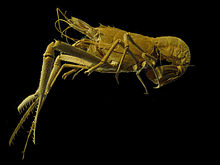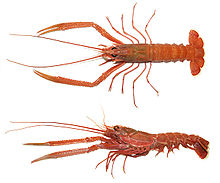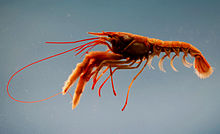
Lobster
Background Information
SOS Children offer a complete download of this selection for schools for use on schools intranets. Child sponsorship helps children one by one http://www.sponsor-a-child.org.uk/.
| Lobster Temporal range: Valanginian–Recent |
|
|---|---|
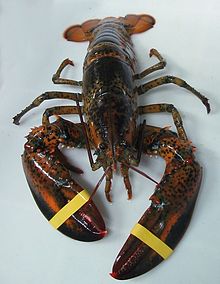 |
|
| American lobster, Homarus americanus | |
| Scientific classification | |
| Kingdom: | Animalia |
| Phylum: | Arthropoda |
| Subphylum: | Crustacea |
| Class: | Malacostraca |
| Order: | Decapoda |
| Infraorder: | Astacidea |
| Family: | Nephropidae Dana, 1852 |
| Genera | |
|
|
Clawed lobsters comprise a family (Nephropidae, sometimes also Homaridae) of large marine crustaceans. They have long bodies with muscular tails, and live in crevices or burrows on the sea floor. Three of their five pairs of legs have claws, including the first pair, which are usually much larger than the others. Highly prized as seafood, lobsters are economically important, and are often one of the most profitable commodities in coastal areas they populate. Commercially important species include two species of Homarus from the northern Atlantic Ocean, and scampi – the northern-hemisphere genus Nephrops and the southern-hemisphere genus Metanephrops. Although several other groups of crustaceans have the word "lobster" in their names, the unqualified term "lobster" generally refers to the clawed lobsters of the family Nephropidae. Clawed lobsters are not closely related to spiny lobsters or slipper lobsters, which have no claws ( chelae), or to squat lobsters. The closest living relatives of clawed lobsters are the reef lobsters and the three families of freshwater crayfish.
Description
Lobsters are invertebrates with a hard protective exoskeleton. Like most arthropods, lobsters must moult in order to grow, which leaves them vulnerable. During the moulting process, several species change colour. Lobsters have 10 walking legs; the front three pairs bear claws, the first of which are larger than the others. Although, like most other arthropods, lobsters are largely bilaterally symmetrical, some genera possess unequal, specialised claws.
Lobster anatomy includes the cephalothorax which fuses the head and the thorax, both of which are covered by a chitinous carapace, and the abdomen. The lobster's head bears antennae, antennules, mandibles, the first and second maxillae, and the first, second, and third maxillipeds. Because lobsters live in a murky environment at the bottom of the ocean, they mostly use their antennae as sensors. The lobster eye has a reflective structure above a convex retina. In contrast, most complex eyes use refractive ray concentrators (lenses) and a concave retina. The abdomen includes swimmerets and its tail is composed of uropods and the telson.
Lobsters, like snails and spiders, have blue blood due to the presence of haemocyanin which contains copper (in contrast, vertebrates and many other animals have red blood from iron-rich haemoglobin). Lobsters possess a green hepatopancreas, called the tomalley by chefs, which functions as the animal's liver and pancreas.
Lobsters of the family Nephropidae are similar in overall form to a number of other related groups. They differ from freshwater crayfish in lacking the joint between the last two segments of the thorax, and they differ from the reef lobsters of the family Enoplometopidae in having full claws on the first three pairs of legs, rather than just one. The distinctions from fossil families such as Chilenophoberidae are based on the pattern of grooves on the carapace.
Longevity
Research suggests that lobsters may not slow down, weaken, or lose fertility with age, and that older lobsters may be more fertile than younger lobsters. This longevity may be due to telomerase, an enzyme that repairs DNA sequences of the form "TTAGGG". This sequence, repeated hundreds of times, occurs at the ends of chromosomes and are referred to as telomeres. Biologists who have studied lobsters argue that they exhibit negligible senescence and that they could effectively live indefinitely barring injury, disease and predation. Lobster longevity allows them to reach impressive sizes. According to Guinness World Records, the largest lobster ever caught was in Nova Scotia, Canada, weighing 20.15 kilograms (44.4 lb) and estimated to be 50 years old.
Ecology
Lobsters are found in all oceans. They live on rocky, sandy, or muddy bottoms from the shoreline to beyond the edge of the continental shelf. They generally live singly in crevices or in burrows under rocks.
Lobsters are omnivores and typically eat live prey such as fish, molluscs, other crustaceans, worms, and some plant life. They scavenge if necessary, and are known to resort to cannibalism in captivity. However, when lobster skin is found in lobster stomachs, this is not necessarily evidence of cannibalism - lobsters eat their shed skin after moulting. While cannibalism was thought to be nonexistent among wild lobster populations, it was observed in 2012 by researchers studying wild lobsters in Maine, where it is theorised that these first known instances of lobster cannibalism in the wild can be attributed to a local population explosion among lobsters caused by the disappearance of many of the Maine lobsters' natural predators.
In general, lobsters are 25–50 centimetres (10–20 in) long, and move by slowly walking on the sea floor. However, when they flee, they swim backward quickly by curling and uncurling their abdomen. A speed of 5 metres per second (11 mph) has been recorded. This is known as the caridoid escape reaction.
Symbiotic animals of the genus Symbion, the only member of the phylum Cycliophora, live exclusively on lobster gills and mouthparts. Different species of Symbion have been found on the three commercially important lobsters of the north Atlantic Ocean – Nephrops norvegicus, Homarus gammarus and Homarus americanus.
As food
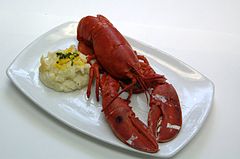 |
|
| Steamed whole lobster, with claws cracked and tail split | |
| Nutritional value per 100 g (3.5 oz) | |
|---|---|
| Energy | 372 kJ (89 kcal) |
| Carbohydrates | 0 g |
| - Sugars | 0 g |
| - Dietary fibre | 0 g |
| Fat | 0.86 g |
| - saturated | 0.208 g |
| - monounsaturated | 0.253 g |
| - polyunsaturated | 0.340 g |
| Protein | 19.0 g |
| Thiamine (vit. B1) | 0.023 mg (2%) |
| Riboflavin (vit. B2) | 0.017 mg (1%) |
| Niacin (vit. B3) | 1.830 mg (12%) |
| Pantothenic acid (B5) | 1.667 mg (33%) |
| Vitamin B6 | 0.119 mg (9%) |
| Folate (vit. B9) | 11 μg (3%) |
| Vitamin C | 0 mg (0%) |
| Calcium | 96 mg (10%) |
| Iron | 0.29 mg (2%) |
| Magnesium | 43 mg (12%) |
| Phosphorus | 185 mg (26%) |
| Potassium | 230 mg (5%) |
| Zinc | 4.05 mg (43%) |
| Percentages are relative to US recommendations for adults. Source: |
|
Lobster recipes include Lobster Newberg and Lobster Thermidor. Lobster is used in soup, bisque, lobster rolls, and cappon magro. Lobster meat may be dipped in clarified butter, resulting in a sweetened flavour.
Cooks boil or steam live lobsters. The lobster cooks for seven minutes for the first pound and three minutes for each additional pound.
According to the United States Food and Drug Administration (FDA), the mean level of mercury in American lobster is 0.31 ppm.
History
In North America, the American lobster did not achieve popularity until the mid-19th century, when New Yorkers and Bostonians developed a taste for it, and commercial lobster fisheries only flourished after the development of the lobster smack, a custom-made boat with open holding wells on the deck to keep the lobsters alive during transport. Prior to this time, lobster was considered a mark of poverty or as a food for indentured servants or lower members of society in Maine, Massachusetts and the Canadian Maritimes, and servants specified in employment agreements that they would not eat lobster more than twice per week. American lobster was initially deemed worthy only of being used as fertilizer or fish bait, and it was not until well into the twentieth century that it was viewed as more than a low-priced canned staple food.
Caught lobsters are graded as new-shell, hard-shell or old-shell, and because lobsters which have recently shed their shells are the most delicate, there is an inverse relationship between the price of American lobster and its flavor. New-shell lobsters have paper-thin shells and a worse meat-to-shell ratio, but what meat exists is very sweet. However, the lobsters are so delicate that even transport to Boston almost kills them, making the market for new-shell lobsters strictly local to the fishing towns where they are offloaded. Hard-shell lobsters with firm shells, but with less sweet meat, can survive shipping to Boston, New York and even Los Angeles, so they command a higher price than new-shell lobsters. Meanwhile, old-shell lobsters, which have not shed since the previous season and have a coarser flavor, can be air-shipped anywhere in the world and arrive alive, making them the most-expensive. One seafood guide notes that an eight-dollar lobster dinner at a restaurant overlooking fishing piers in Maine is consistently delicious, while "the eighty-dollar lobster in a three-star Paris restaurant is apt to be as much about presentation as flavor".
Welfare
The most common way of killing a lobster is by placing it live in boiling water (with or without spending a period of time in a freezer) or by splitting it by severing the body in half lengthwise. Lobsters may also be killed or rendered insensate immediately before boiling by a stab into the brain, in the belief that this will stop suffering. However, a lobster's brain operates from not one but several ganglia and disabling only the frontal ganglion does not usually result in death or unconsciousness. The boiling method is illegal in some places, such as in Reggio Emilia, Italy, where offenders face fines of up to €495.
Fishery and aquaculture
Lobsters are caught using baited, one-way traps with a colour-coded marker buoy to mark cages. Lobster is fished in water between 1 and 500 fathoms (2 and 900 m), although some lobsters live at 2,000 fathoms (3,700 m). Cages are of plastic-coated galvanised steel or wood. A lobster fisher may tend as many as 2,000 traps. Around the year 2000, due to overfishing and high demand, lobster aquaculture expanded. As of 2008, no lobster aquaculture operation had achieved commercial success, due mainly to the fact that lobsters eat each other (cannibalism) and the slow growth of the species; these two problems make it difficult to make lobster aquaculture profitable.
Species
The fossil record of clawed lobsters extends back at least to the Valanginian Age of the Cretaceous. This list contains all extant species in the family Nephropidae:
- Acanthacaris
-
- Acanthacaris caeca A. Milne-Edwards, 1881
- Acanthacaris tenuimana Bate, 1888
- Dinochelus Ahyong, Chan & Bouchet, 2010
-
- Dinochelus ausubeli Ahyong, Chan & Bouchet, 2010
- Eunephrops Smith, 1885
-
- Eunephrops bairdii Smith, 1885
- Eunephrops cadenasi Chace, 1939
- Eunephrops luckhursti Manning, 1997
- Eunephrops manningi Holthuis, 1974
- Homarinus Kornfield, Williams & Steneck, 1995
-
- Homarinus capensis (Herbst, 1792) – Cape lobster
- Homarus Weber, 1795
-
- Homarus americanus H. Milne-Edwards, 1837 – American lobster
- Homarus gammarus (Linnaeus, 1758) – European lobster
- Metanephrops Jenkins, 1972
-
- Metanephrops andamanicus (Wood-Mason, 1892) – Andaman lobster
- Metanephrops arafurensis (De Man, 1905)
- Metanephrops armatus Chan & Yu, 1991
- Metanephrops australiensis (Bruce, 1966) – Australian scampi
- Metanephrops binghami (Boone, 1927) – Caribbean lobster
- Metanephrops boschmai (Holthuis, 1964) – bight lobster
- Metanephrops challengeri (Balss, 1914) – New Zealand scampi
- Metanephrops formosanus Chan & Yu, 1987
- Metanephrops japonicus (Tapparone-Canefri, 1873) – Japanese lobster
- Metanephrops mozambicus Macpherson, 1990
- Metanephrops neptunus (Bruce, 1965)
- Metanephrops rubellus (Moreira, 1903)
- Metanephrops sagamiensis (Parisi, 1917)
- Metanephrops sibogae (De Man, 1916)
- Metanephrops sinensis (Bruce, 1966) – China lobster
- Metanephrops taiwanicus (Hu, 1983)
- Metanephrops thomsoni (Bate, 1888)
- Metanephrops velutinus Chan & Yu, 1991
- Nephropides Manning, 1969
-
- Nephropides caribaeus Manning, 1969
- Nephrops Leach, 1814
-
- Nephrops norvegicus (Linnaeus, 1758) – Norway lobster, Dublin Bay prawn, langoustine
- Nephropsis Wood-Mason, 1872
-
- Nephropsis acanthura Macpherson, 1990
- Nephropsis aculeata Smith, 1881 – Florida lobsterette
- Nephropsis agassizii A. Milne-Edwards, 1880
- Nephropsis atlantica Norman, 1882
- Nephropsis carpenteri Wood-Mason, 1885
- Nephropsis ensirostris Alcock, 1901
- Nephropsis holthuisii Macpherson, 1993
- Nephropsis malhaensis Borradaile, 1910
- Nephropsis neglecta Holthuis, 1974
- Nephropsis occidentalis Faxon, 1893
- Nephropsis rosea Bate, 1888
- Nephropsis serrata Macpherson, 1993
- Nephropsis stewarti Wood-Mason, 1872
- Nephropsis suhmi Bate, 1888
- Nephropsis sulcata Macpherson, 1990
- Thaumastocheles Wood-Mason, 1874
-
- Thaumastocheles dochmiodon Chan & Saint Laurent, 1999
- Thaumastocheles japonicus Calman, 1913
- Thaumastocheles zaleucus (Thomson, 1873)
- Thaumastochelopsis Bruce, 1988
-
- Thaumastochelopsis brucei Ahyong, Chu & Chan, 2007
- Thaumastochelopsis wardi Bruce, 1988
- Thymopides Burukovsky & Averin, 1977
-
- Thymopides grobovi (Burukovsky & Averin, 1976)
- Thymopides laurentae Segonzac & Macpherson, 2003
- Thymops Holthuis, 1974
-
- Thymops birsteini (Zarenkov & Semenov, 1972)
- Thymopsis Holthuis, 1974
-
- Thymopsis nilenta Holthuis, 1974
